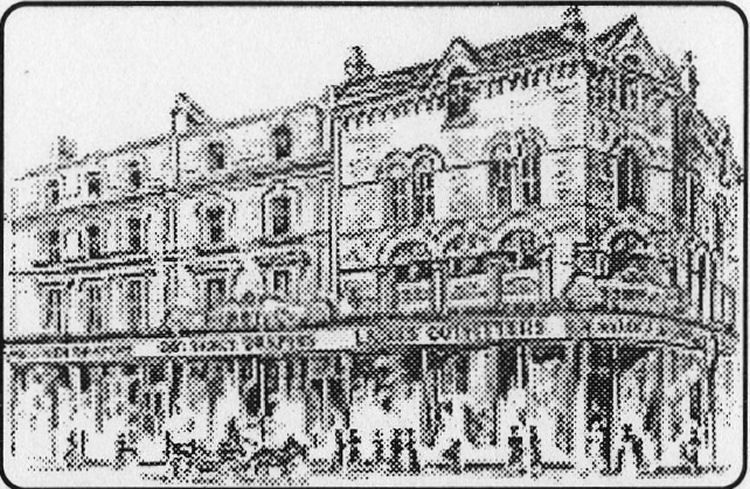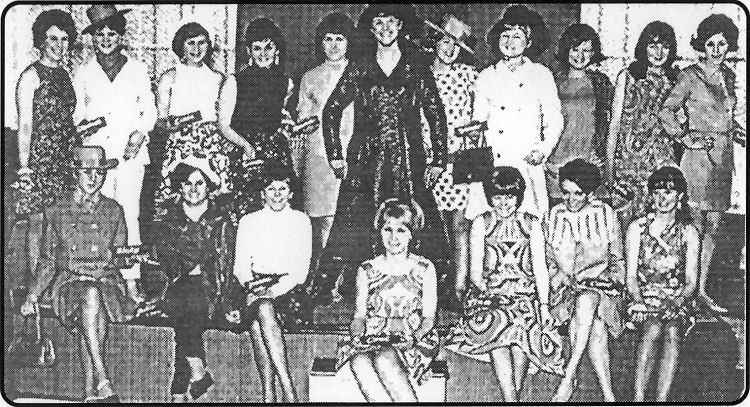Page Updated:- Sunday, 07 March, 2021. |
||||||||||
 From the Folkestone Herald Published 16 December 1999 
An early engraving of Bobby’s popular Folkestone store in Rendezvous Street before the move to Sandgate Road from the new book
Success story MANY happy memories of one of Folkestone’s popular landmarks, Bobby’s department store in Sandgate Road - now Debenhams - are recalled in an interesting and well illustrated booklet about the shop and the men and women behind it, which has just been published. 
TEENS and Twenties fashions of the “Kinkajou Boutique” modelled by “Kinkajou miniquins” with “Miniquin Parades” in the revamped restaurant of the Sandgate Road store in 1967 - part of an effort to attract more young women into the shop. One popular line was made up of paper dresses.
Compiled by June and Ken Paine, of Castle Hill Avenue, keen members of Folkestone and District Local History Society, and produced by PDC Copyprint, Folkestone, the booklet traces the history of the Bobby’s business back to the end of the last century. It was in 1896 that Mr C. J. Saunders, draper, glover and lace man and also a mantle maker traded at 13-17 Rendezvous Street, known at that time as Bouverie House. It was of yellow brick, the lower floors painted white, whereas most of the town’s shop fronts of the time were in dark colours. There was a staff of 40 to 50. The shop became well known among the ladies of the ‘Court’ who travelled from Folkestone to Paris for the Spring and Autumn fashion collections. These ladies brought back catalogues and asked C.J. Saunders to produce copies of the outfits for them. This enabled local women to wear the latest fashions at a fraction of Paris prices. Frederick J Bobby came on the scene after Mr Saunders’ death in 1906. He had already opened a store in Margate, in 1887. Another followed in 1890 in Leamington Spa and they were so successful he set out to open stores at seaside towns round the coast, and so Folkestone’s Bobby’s store came into being in 1906. Bobby & Co Ltd started by offering the entire stock of the store, priced at £8,000 - a lot of money in those days - for sale at ‘low clearing rates.'
5am Queue. Queues of people formed for days and coaches from all the large houses in the area were reported to have jammed the street. Some of the maids sent to snap up bargains for their employers arrived outside the store as early as 5am. There was so much stock the sale went on for three weeks. By 1908 Bobby’s was well established and the first motor delivery van - with solid tyres and driver’s cab open at the sides - arrived advertising on its sides the firm’s three successful shops. In 1914 the store having become cramped Frederick Bobby acquired seven houses in Sandgate Road on the present site to enlarge it and planned a glazed awning over the pavement for the length of the shop. Local people were given the chance to invest in shares in the business and there was a promise that staff would be allotted 72,000 shares when the new premises were built. But the First World War saw the plans put on hold. Bobby’s put the seven houses at the disposal of Belgian refugees, but a sign on the first floor balcony made it clear this was the site for a new Bobby’s shop. Work on building it did not begin until 1920, however, after demolition of 40-60 Sandgate Road. But things did not go smoothly and Mr Bobby clashed with the Council and Mayor. In October Bobby’s and Plummers stores united. Mr Bobby retired and handed over control of the company to his eldest son Arthur, the first manager of the Folkestone store, while his second son Herbert took over the Rendezvous Street store, his younger brother Wilfred becoming assistant manager. Foundation work and creating a waterproof basement proved difficult and it was between 1929 and 1930 before the store began to take shape. A frontage with 450ft of display windows and spacious and well decorated interior introduced a new concept in shopping in Folkestone, with a grand tea room and cafe with seating for 350 thrown in. It was intended to rival the most modern London stores -and 4,000 invitations went out to local dignitaries for the big opening on March 6,1931, which followed a closing down sale at the Rendezvous Street store. There was one snag, Martin Walters had their car showrooms at 62-66 Sandgate Road and these frustrated Bobby’s hopes to extend the store round the corner to Bouverie Place. Then Martin Walters moved to another site and rivals Lewis & Hyland moved in next door. But Bobby’s continued to flourish, and its restaurant served lunch to nearly 18,000 people in summer, but it was 1935 before Lewis & Hyland left and Bobby’s were able to extend the store round the corner, opening by Christmas. By this time it had become part of the Debenhams group, although few people realised it. In fact Debenhams were happy to trade as Bobby’s for 40 years alongside Plummers who also became part of the group. Bobby’s held live shows, had an orchestra for dinner dances and there were various other attractions over the years. Herbert Bobby left after 22 years in 1944 to become MD of a firm in Nottingham, Wilfred Bobby staying on as assistant manager, retiring in 1962. In 1956 the store celebrated its Golden Jubilee. Twelve years later Harold Bobby, manager for 12 years left. Four years later the name Bobby’s was finally dropped. Its an interesting story and there's more to read in the book which is on sale for £2.85 at the Public Library at Grace Hill or the Society's monthly meetings.
|
||||||||||
|
If anyone should have any a better picture than any on this page, or think I should add one they have, please email me at the following address:-
|
||||||||||
| LAST PAGE |
|
MENU PAGE |
|
NEXT PAGE | ||||||
